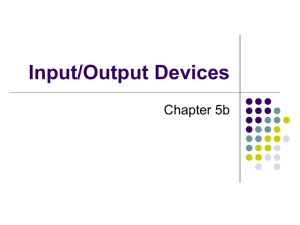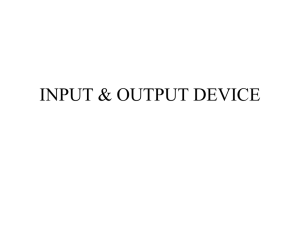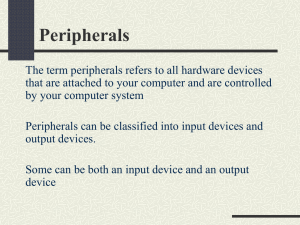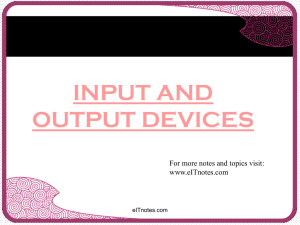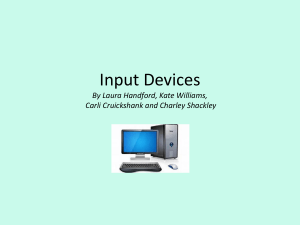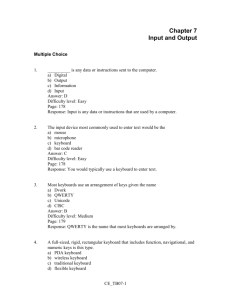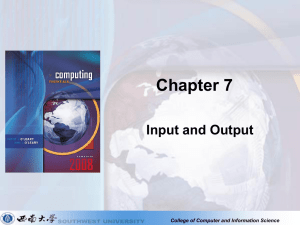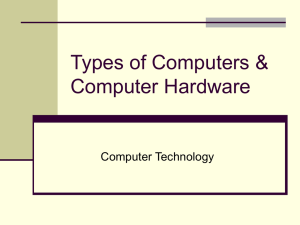INPUT AND OUTPUT UNIT
advertisement
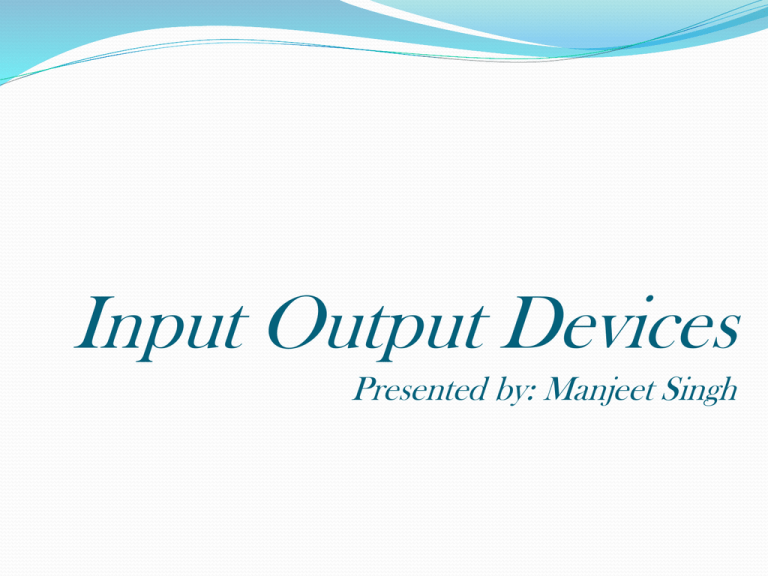
Input Output Devices Presented by: Manjeet Singh INPUT AND OUTPUT UNIT INPUT UNIT: The input unit gets the idea and program from various input devices. The data is provided through input devices such as Key board, Mouse, track ball and joystick. Input data can also be provided by scanning images, voice recording, video recording etc. OUTPUT UNIT : The output unit gets the processed data from computer and sends it to output devices to make them available for the user of computer. The output data is provided through output devices like display screen, printer, plotter and speaker. In addition to input and output devices, some devices function as both input and output devices. The input and output devices provide the input to computer as well as get output from computer. LIST THE DIFFERENT INPUT AND OUTPUT DEVICES : Input devices: key board, mouse, track ball, joystick, touch screen, light pen, speech recognition system, digital camera, scanner, MICR, OCR, OMR, barcode reader. Output devices : Monitor, visual display terminal, printer, plotter, computer output on Microfilm(COM), videos output system, audio response system. Input output devices : Hard disk drive, floppy disk drive, USB drive, CD drive, DVD drive. INPUT DEVICES Input devices allow user and other applications to input data into the computer, for processing. The data input to a computer can be in the form of text, audio, video, etc. Input devices are classified as follows :Human data entry devices :Keyboard Pointing devices – mouse, track ball, joystick Pick devices – light pen, touch screen. Source data entry devices :Audio input- speech recognition Video input- digital camera Scanner- hand held scanner, flat bed scanner Optical scanner- OCR, OMR, MICR, barcode reader. Human Data Entry Devices Input device that require data to be entered manually to the computer are identified as human data entry devices. The data may be entered by typing or keying in, or by pointing a device to a particular location. (1) KEYBOARD :- Features :- Keyboard is a common input device. It is used for entering the text data for inputting the data user types the data using the keyboard. When the data is being typed, the display monitor displays the typed data. Cursor is a vertical line, an underscore, blinking line etc. Working :- When a key is pressed, keyboard interacts with a keyboard controller and keyboard buffer. The keyboard controller scores the code of pressed key in keyboard buffer and informs the computer software that an action has happened on the keyboard. POINTING DEVICES :- These devices are used for providing the input to computer by moving the device to point to a location on computer monitor. Operations like move, click and drag can be performed using the pointing devices. Mouse, track ball, joystick and digitizing tablet are some of the common pointing devices. MOUSE Features:- it is the most common pointing input device. The mouse may also be used to position the cursor on screen, move an object by dragging, or select an object by clicking. It provides an easy way to select and choose commands from menus, dialog boxes, icons etc. Description :- Mouse is a small hand-held device having 2 or 3 buttons on its upper side. Mouse also has a small wheel button. A mouse is classified as physical mouse and optical mouse. Working :- In a physical mouse, rollers and sensors are used to sense the direction and rate of movement of mouse. When an optical mouse is moved, a beam of light is reflected from its underside. TRACK BALL : Features:- Track ball is a device that is a variant of the mouse but has the functionality of mouse. It is easy to use and takes less space than a mouse. Track ball is generally built in laptops since there is no space for the mouse to move on the lap. Working :- Track ball works in the same way as a physical mouse JOYSTICK Features : Joystick is a device which is commonly used for playing video games. Joystick is mainly used to control the speed of cursor and is thus popular in games involving speed like racing and flying games. DIGITIZING TABLET : Features : It is an input device used primarily to input drawings, sketches etc. It is used for Computer Aided Design (CAD) for the design of buildings, maps etc. Description : It consist of two parts-electronic tablet and pen. The electronic tablet is a flat bed tablet. The pen looks like a ball pen but has an electronic head. PICK DEVICES Pick devices are used for providing input to the computer by pointing to a location on the computer monitor. Light pen and Touch screen are some common pick devices. Light pen : Features : It is a light sensitive pen-like input device and is used to select objects directly on the screen. It is used for making drawing, graphics and for menu selection. TOUCH SCREEN: Features : It is an input device used in applications like Automated Teller Machine (A T M),public information computer like Hospitals, airline reservations etc. Description : It consist of a clear glass panel that is placed over the view area of computer screen. Working : Touch screen have an infrared beam that criss cross the surface of screen. Some touch screen have ultrasonic waves that cross the surface of screen. Source Data Entry Devices AUDIO INPUT DEVICE : It can be provided to the computer using human speech. It can be used for making telephone calls, to record voice etc. VIDEO INPUT DEVICES : It is provided to the computer using Video Cameras and Digital Camera. Video camera capture full motion video images. Digital camera works like video camera but can capture still images. OPTICAL INPUT DEVICE :It allow computers to use light as a source of input. Common optical input devices are MICR,OMR,OCR and Bar Code Reader. SCANNER TYPES OF SCANNER : Hand Held Scanner : They are portable and are placed over the document to be scanned. They have to be moved at a constant speed over the document to be scanned. Flat Bed Scanners : They provided high quality scan in a single pass. It is a box shaped machine similar to a photocopy machine and has a glass top and a lid that covers the glass. OPTICAL CHARACTER RECOGNITION (OCR) An optical character recognition is a technique for the scanning of a printed page, translating it, and then using the OCR software to recognise the image as ASCII text that is editable.OCR is used to read character of special type font printed on conventional paper with conventional ink. MAGNETIC INK CHARACTER READER (MICR) MICR reads these characters by examining their shapes, using a 7* 10 matrix, it determines, from the response of the segments of the matrix to the magnetic head. It is mostly used in bands. OPTICAL MARK READER (OMR): In this method, special preprinted forms are designed with boxes which can be marked with a dark pencil or ink. Such a document is read by a document reader called optical mark reader which transcribes the marks into electrical pulses which are transmitted to the computer. BARCODE READER They are adjacent vertical lines of different width that are machine readable. They are fast and accurate. They enable faster service to the customer and are also used to determine the items being sold, no. of each item or to retrieve the price of item. Output Devices Output devices provide output to the user, which is generated after processing the input data. Output devices are classified as follows: HARD COPY DEVICES: The output obtained in a tangible form on a paper or any surface is called hard copy output. Printer, Plotter and microphone are common hard copy output devices. Printer A Printer prints the output information from the computer onto a paper. Printers can be divided into distinct categories: (A) IMPACT PRINTER: *Line Printers : A printer prints a complete line at a time. Printing speed vary from 150 lines to 2500 lines per minute with 90 to 100 characters on 15 inch line. There are two types of line printers : (a) Drum printer : it consists of cylindrical drum on which characters are embossed. A printer can print up to 132 characters per line. (b) Chain printer : it consists of steel band on which the characters are embossed. *Character printers : they print one character at a time, with the print head moving across a line. These printers normally print 30 to 300 characters per second (CPS). (a) Dot Matrix printers : it is the most popular serial printer. In the DMPs , the capital letters are formed by using 5* 7 matrix of dots that is 5- dot rows and 7 – dot columns. (B) NON-IMPACT PRINTERS: These are faster and quierer than impact printers. they produce high quality output and can be used for printing text and graphics in black and white color. *InkJet printers : Some printers direct a high velocity stream of ink towards the paper. In some systems the ink stream is broken into droplets by an ultrasonic transducer. *Laser printers : these printers make use of office copier technologies. The speed can be up to 10- 15 pages per minute. COMPUTER OUTPUT ON MICROFILM A microfilm is in fiche or roll format and is used to record computer output directly from the computer tape or cartridge. COM is a high speed low cost process. The standard roll film is 16 mm wide with a film image that is 1/24 of the original document. COM is used for storing output in banking and insurance applications , medical X-rays etc.

